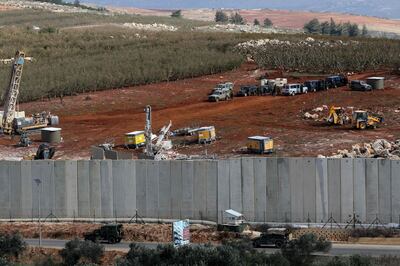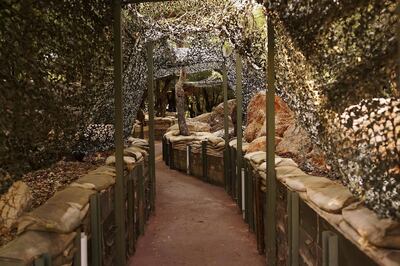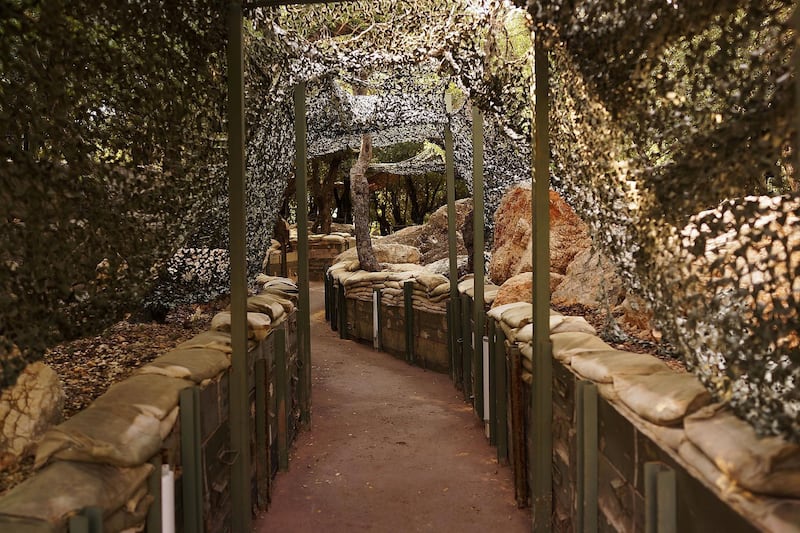The announcement this week by Israeli authorities that they had uncovered cross-border tunnels dug by Hezbollah fanned nearly 12 years of speculation about the efforts of the Iran-backed force.
This is the first time Israeli authorities have made such a claim, showing videos and pictures of the passageway stretching 40 metres beneath the border from Lebanon, although rumours that such tunnels exist have circulated in Israeli and Lebanese media since the end of the 34-day war between Israel and Hezbollah in 2006.
The announcement came more than four years after the Israeli military first started looking into Hezbollah tunnels along its northern border, after residents reported hearing suspicious digging and drilling noises near the frontier. Initial searches turned up nothing.
Prime Minister Benjamin Netanyahu said the tunnel, which is about 1.8m high by 1.8m wide, is part of a wider effort to "inflict great damage" to Israel and Israeli citizens, while an anonymous Israeli officer told The Times of Israel that Hezbollah planned to use the tunnels as part of a wider operation to conquer parts of Israel's Galilee in a future conflict.
But Nabih Berri, Lebanon's speaker of parliament and a longstanding Hezbollah ally, said that Israel had not presented "co-ordinates or information" about the tunnels to back its claims.
Other Hezbollah-allied Lebanese officials dismissed Israel's sudden revelation as an attempt to distract Israeli public opinion from domestic concerns, including accusations of bribery and fraud that have been brought against Mr Netanyahu and his wife.
A UN peacekeeping force stationed along the frontier said that it will dispatch a team of investigators to determine the authenticity of Israel's claims.
______________
Read more:
[ Lebanon says Netanyahu is hiding behind tunnels to deflect from domestic woes ]
[ Israel touts footage of Hezbollah members in cross-border tunnel ]
[ Hezbollah releases new video threatening top Israeli sites ]
______________
“To my knowledge, no one in the open source has seen specifics on these purported tunnels. What I can say is that the burden of proof rests on Israel. It would have to be specific, verifiable, and irrefutable, or the price is [Israeli] credibility in one of the Middle East’s most sensitive games of regional deterrence,” said Aram Nerguizian, co-director of the Programme on Civil-Military Relations in Arab States at the Carnegie Middle East Centre in Beirut.
But Mr Nerguizian noted that “Hezbollah has made it no secret that in the event of any future war, their stated preference is to shift the centre of gravity to Israeli territory”, which implies that tunnels could be a possibility.
Thanassis Cambanis, a senior fellow at the Century Foundation and author of A Privilege to Die, about Hezbollah during the 2006 war, said that “it is possible and plausible” that the party was engaging in cross-border tunnel building.
“Hezbollah works hard to keep its military options open and to maintain what it sees as a balance of power on the border with Israel. We should always assume that Hezbollah, like Israel, is working around the clock to maximise deterrence capabilities,” he told The National.
Mr Cambanis also cited public statements made by Hezbollah chief Hasan Nasrallah in recent years, in which the leader said that his group possessed new offensive capabilities that they did not have during the 2006 war.
“Mr Nasrallah has said if there is the next war there will be fighting on Israeli territory and not only inside Lebanon as was the case last time. The implication is that Hezbollah has figured out a way to infiltrate Israeli territories and it stands to reason that tunnels are one option,” Mr Cambanis said.

Israel claims that the one tunnel it has exposed so far was dug from under a cement factory in the Lebanese village of Kafr Kila. Israeli forces were looking at at least three other sites along the border, including in the Western Galilee, as of Wednesday evening. It is unclear how many other tunnels Israel believes there are.
Lebanese media outlets visited the cement factory on Wednesday and found a chicken farm.
While the geological makeup of the border area is not conducive to covert underground digging – the strong limestone requires heavy machinery and sometimes the use of explosives such as dynamite – the village of Kfar Kila is one of only two villages in southern Lebanon with buildings directly adjacent to the Israeli border. This makes an underground tunnel from that area convenient, as opposed to other villages where the border is hundreds of metres away.
So the choice of Kfar Kila as an entry point would make sense considering its proximity to Israel, analysts said.
The Israeli army said the Hezbollah tunnel discovered on Tuesday had taken more than two years to excavate and that it was fitted with electrical and communication lines as well as ventilation systems.
But it remains unclear why Israel did not expose the tunnel until now. The Israeli military has fibre-optic cables and ground-penetrating radars that would allow its troops to detect underground digging activity along the border. The Israeli military also has audio systems that allow troops to identify suspicious sounds underground.
Former Israeli defence minister Moshe Ya’alon told Army Radio on Thursday that Israeli officials knew about the existence of Hezbollah’s cross-border attack tunnels for years before Tuesday’s announcement.
“For me the question is why now and why the publicity,” Mr Cambanis said. His reasoning was that the whole event “reeks of strategic PR”.
Despite the numerous questions around Tuesday’s announcement, tunnel tactics are not new to Hezbollah. The party has used such systems to store weapons and protect personnel since the mid-1990s when it was fighting against Israel’s invasion of south Lebanon.
Hezbollah’s so-called Resistance Museum, about 35km from Israel in the southern town of Mleeta, includes an original 200m tunnel and bunker system with sleeping areas and prayer rooms used by Hezbollah fighters at the time. Dug during Hezbollah’s years long insurgency against Israeli occupation of south Lebanon that ended with Tel Aviv retreating in 2000. The tunnel was undiscovered for years and was used again during the 2006 war.

Towards the end of the conflict, Israeli forces identified an extensive network of underground tunnels and bunkers in border areas in south Lebanon, some just metres from the Israeli frontier, such as tunnels in the Labbnoune area near Naqoura.
Benjamin S Lambeth, a senior researcher with the Rand think tank, said the bunkers were 40m underground, covering an area of two square kilometres. They reportedly included firing positions, operations centres, connecting tunnels, medical facilities, weapon and ammunition stockpiles, ventilation and air conditioning, bathrooms with hot and cold running water, and dormitories, all with a roof built of slabs of reinforced concrete almost a metre thick.
The tunnel, which was discovered and dynamited by Israeli troops, lay just 100 meters from United Nations Interim Force in Lebanon observation posts, as well as a nearby Israeli military position, but neither the Israelis nor Unifil had any idea the bunker existed until Israeli troops stumbled across it at the end of the war, according to a 2015 report by Hezbollah expert Nicholas Blanford.
If Tuesday’s findings are confirmed, that would verify earlier reports alleging cross-border tunnel activity. In 2015, Lebanon’s As Safir newspaper, a pro-Hezbollah daily, reported that Hezbollah had a vast network of advanced tunnels under the Israeli border, with durable concrete, a 24-hour power supply via underground generators, a ventilation system to prevent damp from damaging military equipment and a web of secondary escape shafts in case of attack.
Confirmation, however, would also undermine the work of Unifil and the Lebanese army, who are responsible for maintaining calm along the frontier.





